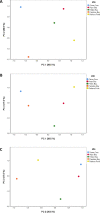Distribution of trace elements in benthic infralittoral organisms from the western Antarctic Peninsula reveals no latitudinal gradient of pollution
- PMID: 34381092
- PMCID: PMC8357953
- DOI: 10.1038/s41598-021-95681-5
Distribution of trace elements in benthic infralittoral organisms from the western Antarctic Peninsula reveals no latitudinal gradient of pollution
Abstract
Antarctica is considered one of the most pristine regions on Earth, but evidences of global and local anthropogenic pollution exist. Chromium (Cr), lead (Pb) and mercury (Hg) are bioaccumulated and sometimes biomagnified through the trophic web. We aim to determine whether a latitudinal gradient of these trace elements exists in benthic organisms along the rocky shores of the Antarctic Peninsula and the South Shetland Islands. Levels of Cr, Pb, and Hg were measured by ICP-MS in two macroalgae (Palmaria decipiens and Desmarestia anceps or Desmarestia menziesii), one gastropod (Nacella concinna), two starfishes (Odontaster validus and Diplasterias brucei), and suspended particulate organic matter (SPOM) from five sampling sites ranging in latitude from 62°11'17″S to 67°33'47″S. Levels of trace elements differed among sites and species, but no latitudinal gradient was observed for these pollutants. Levels of Hg and Pb in animals were consistent with biomagnifications along the food web, as were higher is starfish than in limpets. However, macroalgae and SPOM are unlikely to be the main primary producers supporting those consumers, as Hg levels in macroalgae and Pb levels in SPOM were much higher than in animals. The levels of trace elements detected were similar or higher than in other Antarctic places and other regions of the world, thus indicating that the Antarctic Peninsula area is as polluted as the rest of the world.
© 2021. The Author(s).
Conflict of interest statement
The authors declare no competing interests.
Figures




Similar articles
-
Latitudinal changes in the trophic structure of benthic coastal food webs along the Antarctic Peninsula.Mar Environ Res. 2021 May;167:105290. doi: 10.1016/j.marenvres.2021.105290. Epub 2021 Feb 27. Mar Environ Res. 2021. PMID: 33684658
-
Monitoring trace elements in Antarctic penguin chicks from South Shetland Islands, Antarctica.Mar Pollut Bull. 2013 Apr 15;69(1-2):67-75. doi: 10.1016/j.marpolbul.2013.01.004. Epub 2013 Mar 7. Mar Pollut Bull. 2013. PMID: 23465574
-
Sources of elevated heavy metal concentrations in sediments and benthic marine invertebrates of the western Antarctic Peninsula.Sci Total Environ. 2020 Jan 1;698:134268. doi: 10.1016/j.scitotenv.2019.134268. Epub 2019 Sep 3. Sci Total Environ. 2020. PMID: 31783446
-
Overview of the chemical ecology of benthic marine invertebrates along the western Antarctic peninsula.Integr Comp Biol. 2010 Dec;50(6):967-80. doi: 10.1093/icb/icq035. Epub 2010 May 11. Integr Comp Biol. 2010. PMID: 21558253 Review.
-
Trace element contamination in Antarctic ecosystems.Rev Environ Contam Toxicol. 2000;166:83-127. Rev Environ Contam Toxicol. 2000. PMID: 10868077 Review.
Cited by
-
Viral metagenomics reveals persistent as well as dietary acquired viruses in Antarctic fur seals.Sci Rep. 2022 Oct 28;12(1):18207. doi: 10.1038/s41598-022-23114-y. Sci Rep. 2022. PMID: 36307519 Free PMC article.
-
The predictive model of hydrobiological diversity in the Asana-Tumilaca basin, Peru based on water physicochemical parameters and sediment metal content.Heliyon. 2024 Mar 14;10(6):e27916. doi: 10.1016/j.heliyon.2024.e27916. eCollection 2024 Mar 30. Heliyon. 2024. PMID: 38524626 Free PMC article.
References
-
- IUPAC. Compendium of Chemical Terminology, 2nd ed. (the ‘Gold Book’). Compiled by McNaught, A. D. & Wilkinson, A. (Blackwell Scientific Publications, 1997).
-
- Bolan NS, Adriano DC, Naidu R. Role of phosphorus in (im)mobilization and bioavailability of heavy metals in the soil-plant system. In: Ware GW, editor. Reviews of Environmental Contamination and Toxicology. Springer; 2003. pp. 1–44. - PubMed
-
- Marcovecchio J, Botté S, Domini C, Freije R. Heavy metals, major metals, trace elements. In: Nollet LML, De Gelder LSP, editors. Handbook of Water Analysis. CRC Press; 2013. pp. 379–428.
-
- Wedepohl HK. The composition of the continental crust. Geochim. Cosmochim. Acta. 1995;59:1217–1232. doi: 10.1016/0016-7037(95)00038-2. - DOI
Publication types
LinkOut - more resources
Full Text Sources
Miscellaneous

